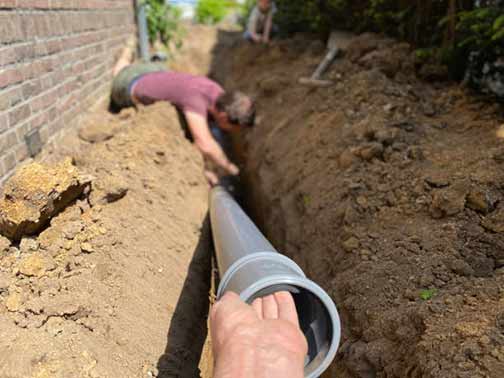
A sewer line belly is one of those drainage problems we don’t talk about often, even though it is a fairly common problem in homes, says B&R Management team. Many homeowners don’t know what a sewer line belly is, its causes, and how to diagnose it.
What is a sewer line belly?
A sewer line belly, or sagging sewer line, is when a low point or dip develops in an underground sewer line. The U-shaped curve that forms prevents the normal flow of wastewater through the pipes.
In addition to impeding the proper flow of water, sewer line bellies also trap solid materials. It predisposes the sewer line to clogs and blockages. That problem may cause sewage to back up into your home or spill on your property.
What causes a sewer line belly?
Sewer line bellies are common in regions with loose sandy soil that shifts easily after heavy rains. Sewer lines in urban areas are more likely to develop bellies because of the prevalence of paved surfaces that encourage flooding and soil erosion in those locations.
Additional factors that may promote the formation of sewer line bellies include:
- Natural soil shifting
The soil underneath a sewer line can lose stability due to soil erosion. The soil structure may also be changed by settling.
- Improperly compacted soil
If soil is poorly compacted before a sewer line installation, the line can lose its support and collapse as the soil shifts.
- Poor sewer line installation
If the sewer line is installed incorrectly, it may not have the correct slope. That will predispose it to developing a belly.
- Heavy rainfall and flooding
Heavy rain and flooding can saturate the soil with water, making it unstable and causing the sewer line to be displaced.
- Nearby construction activities
Heavy construction activities near the location of a sewer line can cause a belly to form in the line.
What are the signs of a sewer line belly?
The same signs of a clogged or blocked sewer line are also present when there is a belly in your sewer line.
- Multiple slow drains inside your home
A single slow drain in your home may not be a big deal. However, if several drains are slow at the same time, the origin of the problem is deep inside your sewer line.
- Frequent drain clogs
Drains that are chronically clogged may be a sign of bigger issues in your drainage system, particularly if you solve one drain clog and another one shows up.
- Gurgling sounds from your plumbing fixtures
Unusual noises – gurgling or sounds of escaping bubbles – show you that air is trapped inside the sewer line. Air can only get trapped inside a sewer line if the line is blocked.
- Foul odors inside the house and around the yard
This problem is also caused by trapped air inside the sewer line. Sewer gases, not finding a way to escape from the sewer line, can roll backward and escape into the home.
- Fluctuations in toilet and sink water levels
Erratic drops and rise in the water level inside your toilet and sink, especially when using another plumbing fixture, could be a sign that you have a sewer line belly.
- Wet spots in the yard
Typically, a sewer line belly will be accompanied by blockages and leaks. That may cause the lawn area directly above the sewer line to become wet or soggy. You may also find that some part of the lawn has unusually green grass.
- Sewage backup inside your home
If the above signs are not heeded and the problem is dealt with promptly, a sewer line belly can eventually cause sewage to flow backward inside the sewer line and into your home.
How to detect and prevent a sewer line belly
The signs of sewer line belly discussed above can also apply to other sewer line problems. The best way to tell with certainty if there is a belly in your sewer line is to have a professional plumber perform a sewer camera inspection.
If the test results show that your sewer line is sagging, you may have to excavate the line to repair it. Fixing a sewer line belly is a costly and time-consuming process. The best way to deal with this issue is to detect it early.
If you live in a region with loose sandy soil and heavy rains, it is advisable to check your sewer line periodically for the telltale signs of a budding sewer line belly. You can prevent sewer line bellies if you:
- Have your sewer line professionally inspected every year or at least once every two years.
- Do a superficial inspection of the plumbing every month to identify dips in performance.
Lastly, it is essential to only work with licensed and experienced plumbers when installing, maintaining, or upgrading your sewer line. A professional plumber will ensure that your sewer line is installed according to the required standards, ensuring optimal performance.


